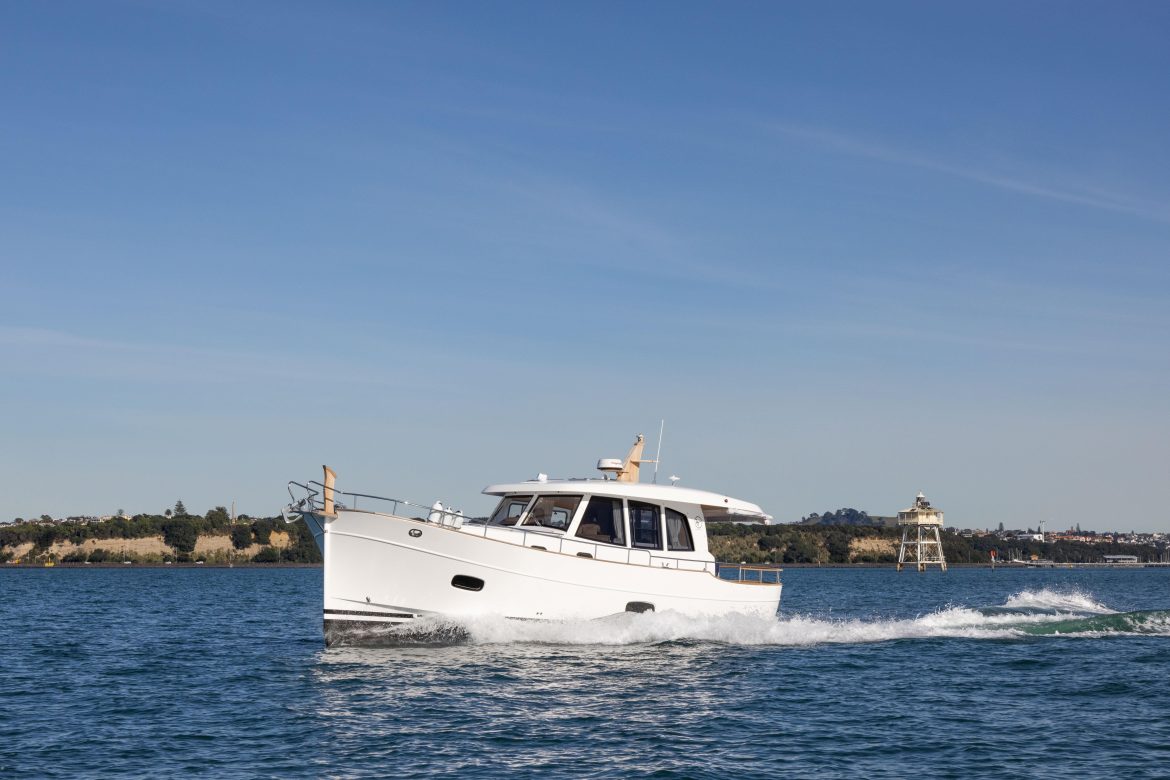The Sasga Menorquin 42 HT represents a rare breed in New Zealand: a European take on a trawler style vessel capable of long-range cruising and handling rough conditions in comfort, with a light brush of retro charm.
All experienced boaties know that feeling of bashing into a boisterous seaway and being passed by a boat that seems to be handling it with ease. For Ernest Henshaw, such a pivotal moment came in 2018 off the west coast of Sardinia. “We were motoring in Mistral conditions [a strong, cold, northwesterly wind that blows from southern France in the northern Mediterranean]. It wasn’t often that we felt uncomfortable in our 28 tonne yacht, but it was quite a nasty sea. Then we were passed by a Sasga Menorquin. We were doing 8 knots; the Menorquin would have been doing 16 or 17 knots, and I couldn’t believe the way it went through the water and handled those conditions. I said, ‘I’m going to get one of those.”’ Two days later, Henshaw was shown through a Sasga Menorquin 39 and was so impressed with the build quality that he did more than buy one. He set up European Marine Imports Ltd to import the brand into New Zealand and engaged marine industry veteran Bruce McGill as broker. They see the target market as the mature boatie, possibly an ex-sailor, who appreciates open water sea handling and traditional nautical design.
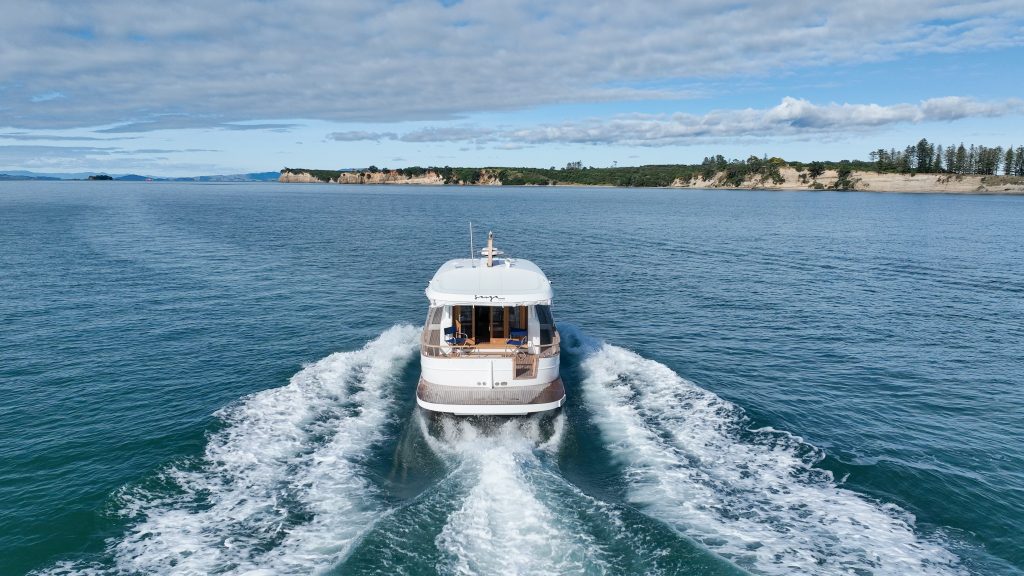
The boats are named for one of the Balearic Islands in Spain, where they are built. Their hull shape reflects those of the traditional Balearic Islands fishing boats, with workboat charm in the straight stem, high gunwales and a fine, flared bow that carves through the sea with a spray-deflecting hard chine running all the way aft. The signature feature is the stem post on the bow profile, a hark back to yesteryear when similar boats were built in timber. The modern construction is resin-infused moulding technology. The Sasga Menorquin 42 HT reviewed here is highwooded, but the wheelhouse is well balanced with a sweet, scalloped sheerline and a rounded canoe stern, finished off with a massive, partially rounded swimboard. The unusual shape of the swimboard suits the boat and helps manoeuvring out of the marina, since there are no hard corners to swing into the dock as the vessel turns. The rounded stern hints at the boat’s Mediterranean origins, although it’s not a true canoe stern, as the hull actually finishes straight across, out of sight beneath the point where the transom meets the swimboard. This means the generous 4m beam extends all the way aft to provide maximum space in the engine room. The Sasga 42 will appeal to those who appreciate lower fuel bills and a steady gait through the waves. Children will love the enclosed cockpit and high bulwarks which provide a safe, sheltered play space. There is sheltered access for’ard to the bow for mooring duties, fishing, carrying food forward to the for’ard sun deck, or enjoying the fresh air while underway. From the marina, boarding is an easy step onto the vast swimboard; a step up into the cockpit, close the gate and you’re home safe – in a clear space surrounded by a solid, curving gunwale with a substantial teak caprail.
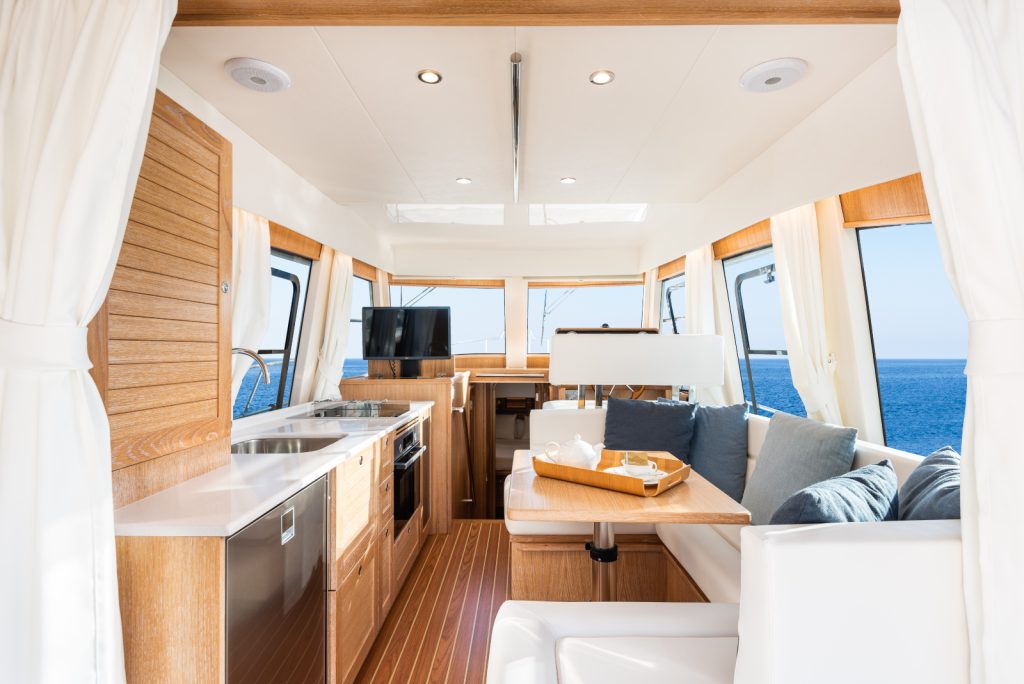
On this boat, everything is substantial. There’s a lot of timber: teak decks, timber trim beneath the permanent canopy over the cockpit and a hefty length of teak for the step into the saloon and galley via attractive, timber bi-fold doors. The cockpit is sparsely furnished with just one permanent seat for two over a locker. It’s a blank canvas, awaiting folding table and director’s chairs which could be stowed in the vast engine room beneath the cockpit. There is a hot and cold shower in the transom for use on the swimboard. At anchor, the swimboard is the boat’s private beach, with a large locker to stow fun gear. In inclement weather, the clears, managed with substantial clips, are easily deployed to enclose the cockpit in all weathers, and take advantage of the saloon’s air-conditioning and heating. This is an indoor-outdoor flow kind of boat, with the bi-fold doors providing instant access to the mid-size galley, to port. The main living space is slightly elevated to provide a good view through the large windows. Amidships, windows slide open vertically for ventilation.
The galley makes diligent use of space thanks to dedicated compartments for cutlery, crockery, glassware and pans. It is well equipped with a front-opening fridge, a 60-litre fridge with freezer, twin electric ceramic hob with pan brackets, large sink and a countertop in Silestone marble, electric oven with microwave, and an extractor hood above. For’ard, the galley meets a large, flat-topped cabinet. In the old days this would be handy for reading paper charts, of which I’m still a fan. Protected with a tea towel or cutting board, it would enhance the galley space and it’s still handy for leaning on while talking to the helmsperson. The cabinet is home to a 28-inch TV which rises on command from a remote control. The saloon dining table with upholstered, three-sided seating for six is to starboard opposite the galley, with a clear divide from the helm. The table seating converts to a double berth. The helmseat, with room for two and a small fridge underneath, is the skipper’s happy place.
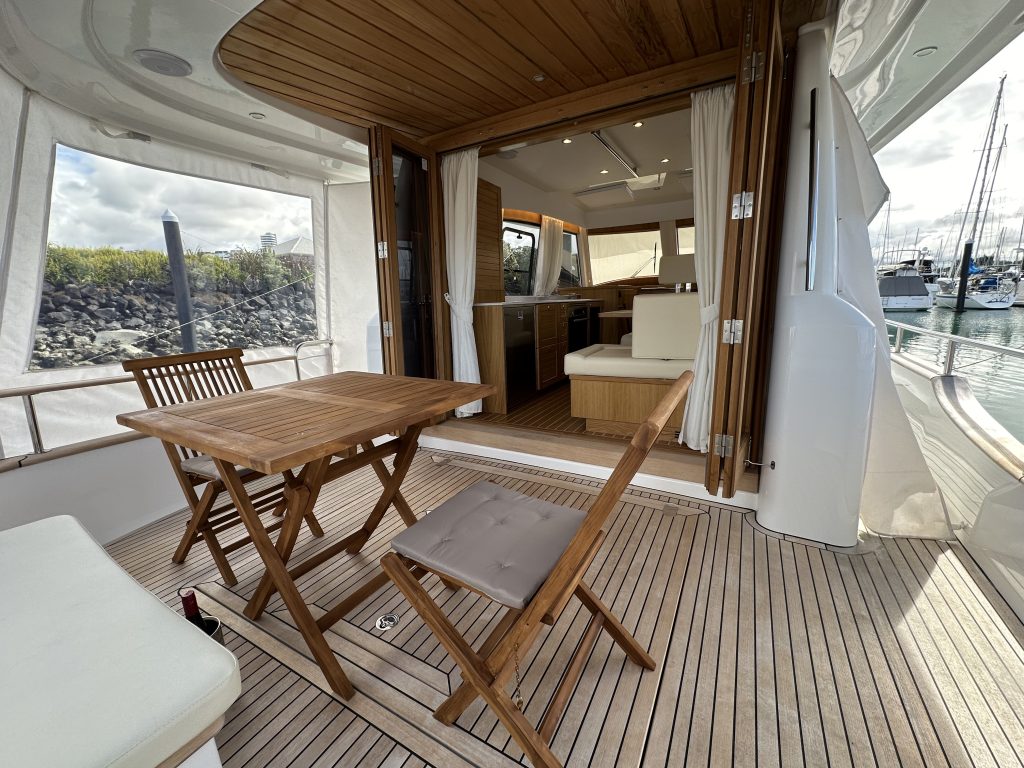
There’s a full suite of Raymarine electronics including radar, plotter and depth sounder displayed on a 12-inch touch screen. These are complemented by controls for VHF radio with AIS trans/receive, auto anchor, searchlight, Zipwake, bow thruster and full Volvo controls and instrumentation. Opposite the helm adjacent to the galley is the electrical control panel for all D/C and A/C components including shore power and generator. For our outing, McGill and I were the full crew complement, but it was easy to see how the Sasga 42 would work with a family outing, with quiet spaces and play spaces; a fishing cruise, charter boat or even a venue for a small, second-time-round wedding.
It also demonstrated the ease of using the boat short-handed. First up, manoeuvring. In the marina, McGill manoeuvred the 12-tonne vessel almost solely on the twin throttles, only using the bow thruster occasionally. His strategy, he says, is to make multiple small moves. Soon, we were clear of Westhaven Marina and heading into the Waitemata Harbour. In a mild sou-westerly in open water, the boat was a steady platform heading downwind. To adjust the trim fore and aft, and laterally, the Sasga 42 has Zipwake interceptor blades that lift and lower to affect the boat’s attitude in the water. ‘When you have the Zipwake on auto,’ McGill says, ‘it will sense the boat’s pitch or roll and adjust to stabilise the ride. All Sasgas have a relatively full keel which obviously contributes to their amazing sea keeping ability.’ The Sasga has a clear foredeck with six beverage holders, handy for sunbathing at anchor. There are three fender brackets either side of the bow, stereo speakers, washdown hose and foot controls for the anchor windlass. The anchor is a 20kg galvanised Bruce with 60m galvanised chain, but there is capacity for a second anchor and/or more chain, thanks to twin anchor rollers and one massive anchor locker.

The helmsperson can manage anchoring from the helm or by reaching through the helm window from the starboard sidedeck. Our homeward run was into the choppy sea. As expected, the Sasga easily chomped through the waves. With twin Volvo D4-320hp engines supplying the power, the Sasga 42 has a top speed of 23 knots, with a cruising speed of 10-17 knots. Accommodation belowdecks is accessed by five steps, offset to port in the for’ard saloon. There are three cabins – a master suite in the foc’s’cle, a twin cabin to starboard and a double island berth to port under the saloon. There are two bathrooms opposite each other, one of which is an en suite for the master cabin. There is a massive volume of storage, which would be great for living onboard. All hatches have sun screens and insect shields. Access to general maintenance points is good.
A massive hatch in the cockpit enables removal of either engine from the engine room. A smaller hatch enables regular access to the engine room via a ladder for routine maintenance and checks. There is space around the twin Volvo D4- 320hp engines for checking filters and fan belts, and good access to other facilities such as air conditioning, hot water and steering systems. The engine room is also home to the 40L hot water cylinder, two fuel tanks with a total capacity of 1200 litres, a 500 litre water tank, a fire-fighting system which can be operated from the helmstation, a 130-litre black water tank and the batteries: five, 95 amp-hour house batteries and two, 95-amp hour engine batteries. The Sasga 42 delivers simple boating. It is excellent for comfortable cruising, easy living, the enclosed cockpit for al fresco entertainment and the huge swimboard is water fun city.
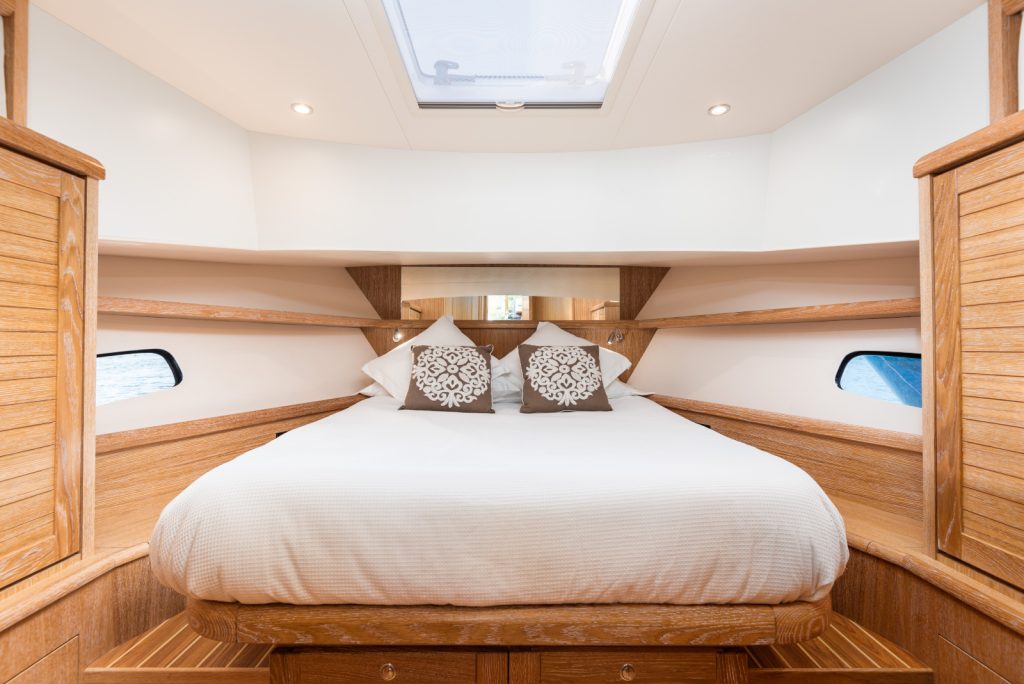

It is built to the European Category A rating, the toughest standard for vessels of more than 40ft. This means it is considered suitable for seas up to 3 metres and winds of 34-40 knots. European Marine Imports has brought five Sasga Menorquins into New Zealand: a Sasga Menorquin 34; two Sasga Menorquin 42, one each in Auckland and Waikawa; and two Sasga Menorquin 54 models. There are two more 54s on order, one of which is sold. Sasga Yachts builds approximately 20 boats a year. Other models include a Sasga Menorquin 68, with a 48 soon to be released. The Sasga 42 and 54 are also available as flybridge models; the 68 is flybridge only. Henshaw delivered a Sasga Menorquin 34 across Cook Strait in a 35-knot nor-wester, with wind against tide pushing up 3-4 metre seas. Most of the trip was on autopilot at around 9 knots boatspeed. “It just went through that sea,” Henshaw says. “The Menorquin can handle offshore difficult conditions. That is why we are importing them.”
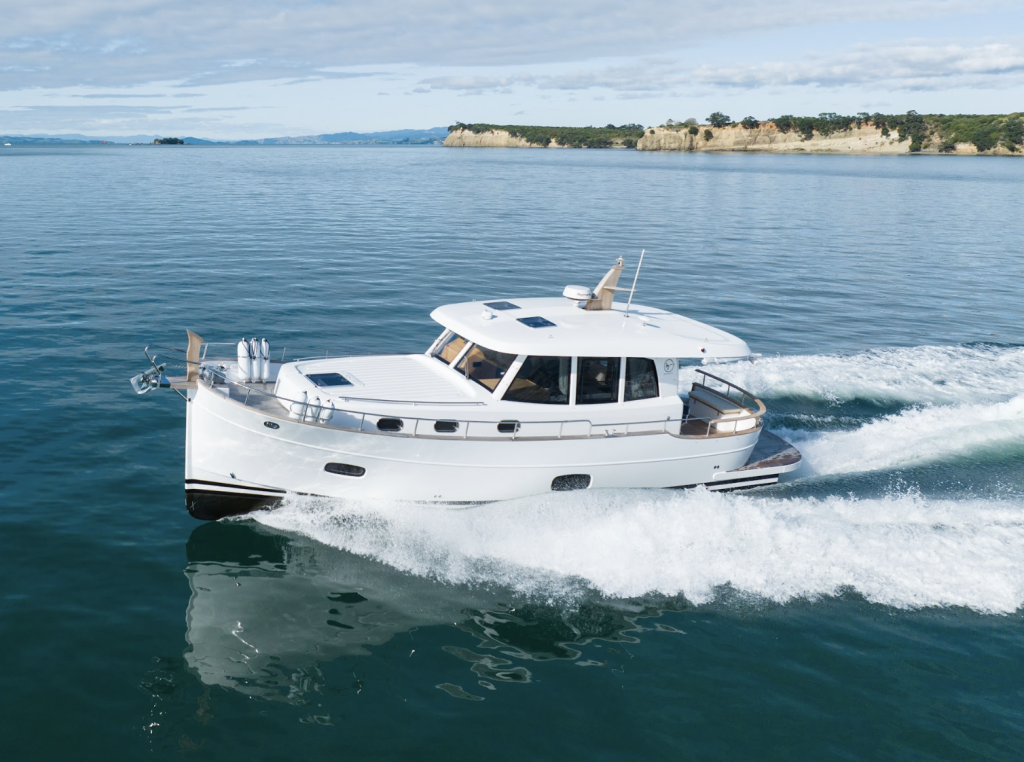
SPECIFICATIONS
- Boat Design Name Sasga Menorquin 42 HT
- Year Launched 2022
- Priced From Available on request
- Style Sedan
- Builder Sasga Yachts
- LOA 14m
- LOH 11.98m
- Beam 4m
- Draft 1.10m
- Displacement (Dry) 12,000kg
- Max Speed 22 knots
- Cruise Speed Up to 19 knots
- Construction GRP
- Fuel Cap 1200 litres
- Water Cap 500 litres
- Engine Options 2 x Volvo D4-320hp
- Stabilisers Zipwake interceptor blades
- Generator Kohler 7kW
- Air Conditioning Webasto
- Navigation Raymarine
- Ent System Fusion
PERFORMANCE
| SPEED | RPM | L/HR |
| 8 | 2000 | 22 |
| 9 | 2200 | 34 |
| 11 | 2500 | 49 |
| 13 | 2750 | 60 |
| 15 | 3000 | 68 |
| 18 | 3250 | 88 |
| 20 | 3500 | 105 |
| 23 (top speed) | 3600 | 122 |
Fuel economy on both engines combined


